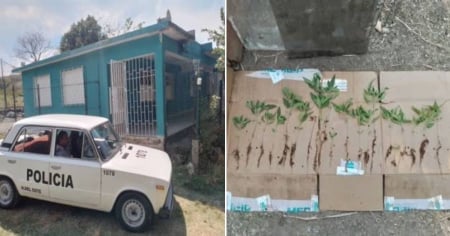A new anti-drug operation in the Havana municipality of Guanabacoa resulted in the arrest of an alleged trafficker of "químico," a highly addictive synthetic drug whose circulation is increasingly concerning to Cuban authorities.
According to information shared on Facebook by the user Guerrero Rojo, identified as a government spokesperson, the capture occurred on Saturday night in the area known as Habana Nueva, in a surprise action carried out by forces from the Ministry of the Interior (MININT).
Although initially the detainee did not have any visible substances, a thorough search revealed that he was hiding several wrapped packages containing drugs inside a jar.
The arrest takes place against a backdrop of increasing public concern over the presence of the "chemical" in vulnerable communities in Havana, where illegal selling points are proliferating despite the reinforcement of police measures.
This new case adds to a series of recent incidents that illustrate the deterioration of control over drug trafficking and consumption.
In March, a graffiti with the message "Chemicals for sale," several meters long, appeared on Pérez Street in the Luyanó neighborhood, Diez de Octubre municipality, causing alarm and speculation among the residents.
The graffiti was removed hours later, though without an official statement regarding it.
Residents in the area and passersby debated whether it was an announcement, an anonymous neighborhood complaint, a provocation, a strategy to alert the authorities, or even a territorial dispute among traffickers.
Just days before that event, the Cuban government had launched the Third Exercise for the Prevention and Combat Against Drug Illegality, a crusade that included public trials, community investigations, roadchecks, and talks in schools and neighborhoods.
However, many question the effectiveness of these measures.
The government's actions, involving institutions such as the Ministries of Education and Health, the Prosecutor's Office, and the Committees for the Defense of the Revolution (CDR), aim to strengthen surveillance and prevention in the communities.
However, experts and citizens agree that institutional responses remain more reactive than preventive, and are not very effective in addressing an issue that is rapidly advancing, especially among young people.
The spread of drugs in communities is not a recent phenomenon, but rather the result of years of neglect regarding the factors that contribute to their expansion, such as the lack of economic opportunities, the deterioration of social services, and the inadequacy of effective public policies in addiction prevention.
The Exercises for the Prevention and Management of Drug-related Illicit Activities are just an attempt to alleviate the damage of a system that has been unable to handle the rise in addictions in Cuba, without a profound transformation of public policies that address the social, economic, and political causes of the crisis.
The arrest in Guanabacoa represents a new attempt to demonstrate control over an increasingly visible reality, but it also reveals the persistence of the phenomenon, despite the official narrative.
Meanwhile, on the streets of Havana, many fear that these types of operations are merely a band-aid for a much deeper problem.
Frequently Asked Questions about Drug Trafficking in Cuba
What is "the chemist" and why is it so concerning in Cuba?
"The chemist" is a synthetic cannabinoid that mimics the effects of marijuana but is much more potent and dangerous. This drug is manufactured illegally, using toxic ingredients such as formaldehyde and veterinary anesthetics. Its consumption has increased in Cuba, particularly among the youth, due to its low cost and rapid effects, but it carries severe health risks, including psychosis, seizures, and loss of muscle control.
How is the Cuban government responding to the issue of drug trafficking?
The Cuban government has intensified drug enforcement operations and has implemented the Third Exercise for Prevention and Combat Against Drug Offenses. These actions include exemplary trials, community investigations, and highway controls. However, many criticize that the measures are more reactive than preventive and do not address the underlying causes of the problem, such as the lack of economic opportunities and the deterioration of social services.
What evidence does the recent arrest in Guanabacoa provide regarding drug trafficking in Cuba?
The arrest in Guanabacoa, where a suspected trafficker of "the chemical" was detained, highlights the growing problem of drug trafficking in Cuba, particularly in vulnerable communities in Havana. Despite the government's efforts, the circulation of drugs remains a significant issue, driven by unresolved economic and social factors.
What is the impact of "the chemical" consumption on Cuban youth?
The use of "the chemical" has devastating effects on the health of young Cubans. In the short term, it can cause euphoria, nausea, tachycardia, seizures, and loss of muscular control. In the long term, it can lead to mental disorders such as anxiety and psychosis, as well as irreversible physical damage. The drug has become a serious social issue, exacerbated by a lack of information and adequate prevention.
Filed under:
